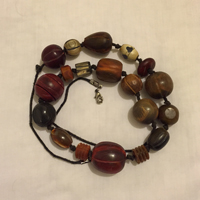 This morning I held these beads in my hand, reflected on our time together, silently thanked them, and placed them gently in the bin.
This morning I held these beads in my hand, reflected on our time together, silently thanked them, and placed them gently in the bin.
I bought these beads at a night market in Broome on our first visit there in 2009. I loved them and wore them so much. They went with everything, were a bit different without being too ‘out there’, and I loved their wooden, natural feel and that they connected me to a time and place that I had such fond memories of. Pretty much everyone I know would have seen me wearing these beads at some point over the last 5 years!
But for the last few months, these beads have been sitting on my bedside table. Unworn and in need of repair. The clasp is broken and my clumsy attempts to reattach it were only short lived. The leather is worn and has broken in several spots – necessitating the addition of several knots to hold it together.
One of the things I’ve noticed since reading The Life-Changing Magic of Tidying Up is how much easier, emotionally speaking, it is to discard my possessions. It was time for the beads to go, and into the bin they went.
The central question that the Kon Mari method focuses on is ‘does this item spark joy?’. In the case of the beads, this wasn’t immediately easy to answer. There was no doubt that these beads did spark joy for me – the happy memories of Broome, all the outfits that the beads accessorised well with, how I felt when I wore them. But the joy is in the past, contained in the memories that the beads elicit. Right now, the beads are unwearable. Their presence on my bedside table is a reminder that I haven’t fixed them and don’t know how to. They represent just another to-do on my never ending to-do list. Right now, in their current form, I had to admit that the beads didn’t spark joy.
I don’t think Marie Kondo writes about this specifically in her book, but it’s important to be aware of tense when asking and answering the ‘joy’ question. It feels quite easy, at least for me, to focus on the joy an item sparked in the past, or the joy that you anticipate that an item might spark at some point in the future. But these are just distractions and an easy way to avoid truly moving towards living a minimalist life. When I focused on the present this broken bead necklace was not something that I needed in my life.
The idea of thanking your possessions sounded a little crazy to me when I first read the book, but silently thanking these beads for all the joy that they’d bought me was actually a surprisingly nice way to bring some closure to our time together.
Farewell beads and thank you.
Leave a Reply